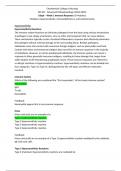Other
NR 507 - EDAPT - Week 1: Immune Response
- Course
- Institution
Chamberlain College of Nursing NR 507 - Advanced Pathophysiology Week 1 EDAPT Module - Immune Response This document includes the full module: Full summary, all questions, all answers, and feedback for each This is everything you need to complete the full EDAPT module very quickly with 100%.
[Show more]



